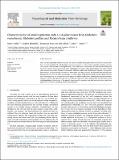Files in this item
Characterisation of arabinogalactan endo β 1,4 galactanases from Globodera rostochiensis, Globodera pallida and Rotylenchulus reniformis
Item metadata
| dc.contributor.author | Leslie, Kerry | |
| dc.contributor.author | Mantelin, Sophie | |
| dc.contributor.author | Eves-van den Akker, Sebastian | |
| dc.contributor.author | Jones, John T. | |
| dc.date.accessioned | 2022-11-16T15:30:03Z | |
| dc.date.available | 2022-11-16T15:30:03Z | |
| dc.date.issued | 2023-01-01 | |
| dc.identifier | 282156052 | |
| dc.identifier | 93d085a7-a297-4511-9a38-ab91bccbbca1 | |
| dc.identifier | 85142004434 | |
| dc.identifier | 000903741200001 | |
| dc.identifier.citation | Leslie , K , Mantelin , S , Eves-van den Akker , S & Jones , J T 2023 , ' Characterisation of arabinogalactan endo β 1,4 galactanases from Globodera rostochiensis , Globodera pallida and Rotylenchulus reniformis ' , Physiological and Molecular Plant Pathology , vol. 123 , 101930 . https://doi.org/10.1016/j.pmpp.2022.101930 | en |
| dc.identifier.issn | 0885-5765 | |
| dc.identifier.other | RIS: urn:390A87AF867D83CD056410EC71A114D7 | |
| dc.identifier.uri | https://hdl.handle.net/10023/26411 | |
| dc.description | Funding: KL was funded by a BBSRC EASTBIO DTP studentship provided through the UKRI Biotechnology and Biological Sciences Research Council (BBSRC) grant number BB/T00875X/1 and by the Rural and Environment Science and Analytical Services Division of the Scottish Government at The James Hutton Institute and The University of St Andrews. Work on plant-parasitic nematodes at the University of Cambridge is supported by DEFRA licence 125034/359149/3 and funded by BBSRC grants BB/R011311/1, BB/N021908/1, and BB/S006397/1. | en |
| dc.description.abstract | Plant parasitic nematodes need to overcome the barrier presented by the plant cell wall in order to invade their host. A variety of plant cell wall degrading enzymes are present in endoparasitic nematodes including enzymes that degrade cellulose (beta 1,4 endoglucanases) and various pectin components. We describe the cloning and functional analysis of genes encoding GH53 arabinogalactan endo-1,4-beta-galactosidases from three related plant parasitic nematodes Globodera rostochiensis, Globodera pallida and Rotylenchulus reniformis. Phylogenetic and structural analyses strongly indicate that these genes have been acquired by horizontal gene transfer from bacteria. We show that the genes are expressed at invasive stages of the parasites in the secretory gland cells. We also demonstrate that the enzymes from these species are biochemically active, showing the expected hydrolytic enzymatic activity when galactan was used as a substrate. This work further demonstrates the importance of cell wall degradation to the success of the parasitic process and the extensive role that horizontal gene transfer has played in the evolution of plant parasitism by nematodes. | |
| dc.format.extent | 8 | |
| dc.format.extent | 4734579 | |
| dc.language.iso | eng | |
| dc.relation.ispartof | Physiological and Molecular Plant Pathology | en |
| dc.subject | Potato cyst nematode | en |
| dc.subject | GH53 | en |
| dc.subject | Horizontal gene transfer | en |
| dc.subject | Plant cell wall | en |
| dc.subject | Transcriptomics | en |
| dc.subject | QH426 Genetics | en |
| dc.subject | QK Botany | en |
| dc.subject | NDAS | en |
| dc.subject | MCC | en |
| dc.subject.lcc | QH426 | en |
| dc.subject.lcc | QK | en |
| dc.title | Characterisation of arabinogalactan endo β 1,4 galactanases from Globodera rostochiensis, Globodera pallida and Rotylenchulus reniformis | en |
| dc.type | Journal article | en |
| dc.contributor.institution | University of St Andrews. School of Biology | en |
| dc.contributor.institution | University of St Andrews. St Andrews Bioinformatics Unit | en |
| dc.contributor.institution | University of St Andrews. Biomedical Sciences Research Complex | en |
| dc.identifier.doi | https://doi.org/10.1016/j.pmpp.2022.101930 | |
| dc.description.status | Peer reviewed | en |
This item appears in the following Collection(s)
Items in the St Andrews Research Repository are protected by copyright, with all rights reserved, unless otherwise indicated.

